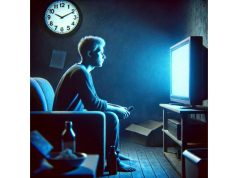
The thrill of clicking “Buy Now,” the rush of swiping a card, the glow of a brand-new package on the doorstep — for most people, these moments are harmless treats. But for millions, spending spirals from occasional pick-me-up to relentless need. Compulsive shopping, also called Oniomania, is a behavioral addiction where acquiring things becomes the quickest route to soothe anxiety, boredom, or low mood, yet leaves deeper debt and regret. Unpacking why the urge hits, how to spot the warning signs, and which tools actually break the cycle can turn shopping back into a choice instead of a chain.
Table of Contents
- Landscape, Statistics, and Modern Shopping Culture
- Drivers, Risk Layers, and Vulnerability Maps
- Behavioral Flags, Symptom Profile, and Clinical Identification
- Financial, Emotional, and Social Fallout
- Evidence-Backed Treatments and Sustainable Recovery Plans
- Frequent Questions and Practical Answers
Landscape, Statistics, and Modern Shopping Culture
Compulsive shopping was first described clinically in the early 1900s, yet only in the past three decades has it gained serious research traction. Epidemiological surveys estimate 3 %–8 % of adults worldwide meet criteria for Oniomania in any given year. Prevalence skews higher among women in older studies, but gender gaps narrow online: flash-sale platforms report nearly equal male-female spending sprees on electronics, gaming gear, and collectibles.
Smartphones extend store hours to 24 ⁄ 7. One-click checkouts compress decision windows from minutes to seconds, while push notifications lure users back at breakfast, lunch, and midnight. “Buy Now, Pay Later” services erode price friction, splitting impulsive splurges into painless-looking installments. Social-media influencers frame purchases as identity curation; unboxing videos transform acquisition into entertainment. In emerging economies, e-commerce adoption leaps faster than consumer-protection laws, making easy credit and counterfeit luxury traps for first-time online shoppers.
Meanwhile, the global pandemic accelerated digital retail by a decade, fusing isolation, stress, and boredom with accessible dopamine hits. Post-lockdown data show average household parcel deliveries doubling compared with 2019. For vulnerable individuals, that flood deepened dependency, turning living rooms into staging areas for unopened boxes. Understanding this cultural backdrop clarifies why treatment must tackle both personal triggers and an environment engineered to stoke them.
Drivers, Risk Layers, and Vulnerability Maps
Compulsive shopping springs from a web of biology, psychology, and environment. Rarely is one thread solely to blame.
Neurobiological Spark
- Reward circuitry hijack — Purchasing lights up the mesolimbic dopamine pathway, the same circuit targeted by drugs and gambling. Anticipation (scrolling wish-lists) can produce a bigger dopamine spike than owning the item, locking users into the chase.
- Serotonin and impulse control — Low baseline serotonin correlates with impulsivity. Some shoppers report a “buzz” similar to mild stimulant use, followed by a crash that fuels the next hunt.
- Stress-axis interplay — Cortisol surges from work or relationship tension make the limbic brain crave quick relief. A discounted handbag or rare sneaker appears as a fast-acting emotional analgesic.
Psychological Layers
- Emotional regulation deficits — People who never learned healthy coping skills for sadness, anger, or boredom may discover retail therapy by accident and then rely on it compulsively.
- Low self-esteem — Purchases serve as external validators (“I’m worthy because I own this status symbol”).
- Perfectionism and control — Curating the “perfect” wardrobe or gadget setup offers an illusion of mastery when life feels chaotic.
- Personality traits — High novelty-seeking, high materialism scores, and high sensitivity to reward elevate risk.
Comorbid Mental-Health Conditions
| Condition | How It Interacts with Oniomania |
|---|---|
| Depression | Spending provides temporary mood lift, but financial guilt deepens depressive spirals. |
| Anxiety disorders | Purchasing rituals calm anticipatory anxiety; packages act as safety charms. |
| Bipolar disorder | Manic or hypomanic episodes often feature impulsive buying sprees. |
| ADHD | Inattention and impulsivity shorten the gap between desire and checkout. |
| Substance use disorders | Cross-addiction patterns: sobriety from alcohol may unmask latent shopping urges. |
Sociocultural Catalysts
- Consumer-centric identity — “Hauls” and “outfit of the day” grids broadcast social capital via possessions.
- Algorithmic targeting — Retargeting ads stalk browsers across sites, eroding resistance.
- Credit normalization — Carrying debt is framed as a rite of passage; interest-free promos lure larger carts.
- Crisis retail — During economic downturns, brands push “little luxuries” narratives, encouraging emotional buys even as budgets shrink.
Recognizing which risk layers dominate for a specific individual guides personalized treatment. An ADHD patient may need executive-function coaching, whereas someone driven by trauma may benefit more from emotion-focused therapy.
Behavioral Flags, Symptom Profile, and Clinical Identification
Spotting compulsive shopping early can prevent years of debt and shame, yet many warning signs masquerade as harmless indulgence.
Red-Flag Behaviors
- Preoccupation with buying — Hours spent browsing deals or planning next purchase, even at work or social events.
- Spending beyond means — Maxed-out credit lines, secret loans, or juggling multiple “Buy Now, Pay Later” plans.
- Chasing the high — Needing bigger or more frequent purchases to achieve the same rush (tolerance).
- Emotional roller-coaster — Euphoria during checkout followed by guilt, shame, or disappointment once the item arrives.
- Hiding activity — Stashing statements, deleting confirmation emails, or shipping to work to avoid partner scrutiny.
- Life disruption — Late bills, strained relationships, lost productivity, or legal troubles related to spending.
Diagnostic Considerations
Although Oniomania isn’t yet a standalone disorder in DSM-5 or ICD-11, clinicians often diagnose it under “Other Specified Impulse-Control Disorder.” Common assessment tools include:
| Instrument | Purpose | Time |
|---|---|---|
| Compulsive Buying Scale (CBS) | Self-report measure of severity | 10 min |
| Richmond Compulsive Buying Scale (RCBS) | Short screener for research and clinics | 5 min |
| Yale-Brown Obsessive Compulsive Scale–Shopping Version (Y-BOCS-SV) | Semi-structured interview assessing urges and behaviors | 20 min |
Clinicians rule out manic episodes, substance intoxication, or psychotic processes that can mimic spending binges. They also assess financial records, credit scores, and partner interviews to gauge functional impairment.
Common Cognitive Distortions
- “I’ll save money in the long run if I stock up now.”
- “This limited-edition drop will never come back.”
- “I deserve it after the day I’ve had.”
- “I can always return it later” (yet returns rarely happen).
Highlighting these thought errors in therapy helps break autopilot loops.
Financial, Emotional, and Social Fallout
Money Pitfalls
- Compound Debt — Interest snowballs; minimum payments barely dent principal, lengthening payoff timelines to decades.
- Credit-Score Damage — Late or missed payments slash scores, hiking insurance premiums and mortgage rates.
- Opportunity Cost — Funds that could build emergency savings or retirement ride out the door in shopping bags.
- Bankruptcy — Severe cases culminate in Chapter 7 or Chapter 13 filings, impacting employment prospects in finance or government roles.
Emotional Toll
- Guilt and Shame — Secret stashes or hidden statements foster self-loathing.
- Anxiety — Constant worry about upcoming bills, partner discovery, or delivery packages stolen off porch before they’re hidden.
- Depressive Spirals — Chronic debt and clutter reinforce beliefs of incompetence and hopelessness.
- Identity Diffusion — Self-worth welded to possessions, making downsizing feel like erasing one’s core.
Relationship Strain
- Breached Trust — Partners feel deceived when debts surface; financial infidelity can wound as deeply as romantic betrayal.
- Power Imbalances — Main earners may start policing every expense, creating parent-child dynamics.
- Isolation — Embarrassment over past purchases or cluttered homes leads to skipped gatherings and social withdrawal.
Occupational Impact
- Productivity Loss — Mid-shift browsing or package tracking consumes work hours.
- Job Instability — Wage garnishment or background credit checks jeopardize promotions in sensitive industries.
- Entrepreneurial Risk — Small-business owners may divert company funds into personal shopping, risking legal consequences.
Health Consequences
While physical harm is less direct than in substance addiction, chronic stress elevates blood pressure, exacerbates migraines, and weakens immunity. Sleep deprivation from late-night browsing further depletes cognitive control, reinforcing the cycle.
Evidence-Backed Treatments and Sustainable Recovery Plans
Oniomania recovery thrives on a multifaceted strategy that tackles emotions, thoughts, behaviors, and finances.
1. Cognitive-Behavioral Therapy (CBT) Tailored for Shopping
Core modules typically span 12–20 weekly sessions:
- Trigger mapping — Diary of situations, emotions, and thoughts preceding purchases.
- Cognitive restructuring — Challenging distortions (“If I own it, I’ll be accepted”).
- Exposure and response prevention — Visiting favorite store or website without buying; learning to ride out urge peaks.
- Delayed-gratification drills — “48-hour rule” before purchase; urge often fades.
- Budgeting homework — Real-time spending logs reviewed with therapist.
Meta-analyses show CBT reduces compulsive buying severity by up to 60 % and maintains gains at 6-month follow-up.
2. Financial Counseling and Debt Management
- Snowball vs. avalanche repayment plans — Choose method aligning with personality (quick wins vs. interest optimization).
- Debt-management programs — Nonprofit agencies negotiate lower interest and consolidate payments.
- Spending fasts — 30-day moratoriums on non-essentials help reset reward circuitry.
- Accountability systems — Joint bank apps where partner or coach sees transactions in real time.
3. Medication Adjuncts
| Target Symptom | Pharmacologic Option | Evidence Notes |
|---|---|---|
| Urge intensity, impulsivity | SSRIs (fluoxetine, sertraline) | Small RCTs show modest reduction in buying episodes; onset 4–6 weeks |
| ADHD comorbidity | Lisdexamfetamine, atomoxetine | Improves executive control, lowers impuls purchases |
| Bipolar spending sprees | Mood stabilizers (lithium, valproate) | Treat underlying mood swings, indirectly curbing shopping |
| Craving loops | Naltrexone (opioid antagonist) | Case studies suggest benefit for urge reduction |
Medication works best as part of an integrated plan rather than stand-alone fix.
4. Digital and Environmental Guards
- App blockers — Tools like Freedom or Cold Turkey restrict shopping sites during vulnerable windows.
- Email filters — Auto-redirect marketing blasts into a “Later” folder reviewed once weekly.
- Card freezing — Fin-tech apps let users lock cards with one tap when cravings hit.
- Cash-only challenges — Physical money triggers greater “pain of paying,” curbing over-spends.
5. Mindfulness-Based Relapse Prevention (MBRP)
Meditation and urge-surfing techniques teach shoppers to observe cravings without immediate reaction. Eight-week MBRP courses show reduced relapse compared with standard CBT alone.
6. Support Groups and Peer Accountability
- Debtors Anonymous employs a 12-step model; “pressure relief” meetings pair members with financial program sponsors.
- Spenders Anonymous online forums share success stories, “no-spend” streaks, and daily gratitude lists replacing consumption dopamine with connection dopamine.
7. Lifestyle Resets
- Values clarification — Writing life-goals helps realign spending with priorities like travel, health, or education.
- Hobby substitution — Channel novelty-seeking into free or low-cost pursuits (hiking, DIY cooking).
- Digital declutter — Unfollow influencer accounts that stoke FOMO; curate feeds toward inspiration, not aspiration.
8. Relapse Prevention and Long-Term Maintenance
- Schedule quarterly “budget check-ups” with counselor or accountability partner.
- Keep a “wish list” document; revisit items after 30 days instead of impulse buying.
- Celebrate milestones (three debt-free statements) with non-monetary rewards: spa day using gift card, library book binge, potluck with friends.
Long-term studies (2–5 years) indicate those who combine CBT, financial coaching, and peer support maintain debt reduction and report improved life satisfaction compared to single-modality interventions.
Frequent Questions and Practical Answers
Is compulsive shopping really an addiction like drugs or alcohol?
Yes. Brain-imaging shows similar reward-pathway activation, and sufferers experience tolerance, withdrawal (restlessness, irritability), and continued behavior despite harm.
Can I treat Oniomania by cutting up credit cards alone?
Removing credit lines helps, but root emotional triggers and cognitive distortions remain. Pair financial barriers with therapy for lasting change.
Are flash-sale apps more dangerous than regular stores?
They can be. Time-limited countdowns spike adrenaline and override rational comparison shopping, amplifying impulse buys.
Does budgeting software cure compulsive spending?
Budget apps increase awareness, yet many users bypass categories when cravings surge. Combine software with motivational interviewing or CBT to sustain usage.
Can medication stop the urge to buy?
Medication may lower impulse strength, especially when mood or ADHD drives shopping, but behavioral skills are essential for long-term management.
How long before recovery feels stable?
Many feel substantial relief within three to six months of consistent therapy and debt action, but relapse vigilance should continue for years, especially during life stressors.
Disclaimer
This information is for educational purposes only and is not a substitute for professional medical, psychological, or financial advice. Always consult qualified professionals for diagnosis, treatment, or debt management tailored to your situation.
If you found value in this guide, please share it on Facebook, X (formerly Twitter), or any platform you enjoy, and follow us for more evidence-based insights. Your support helps us keep producing quality content—thank you!










